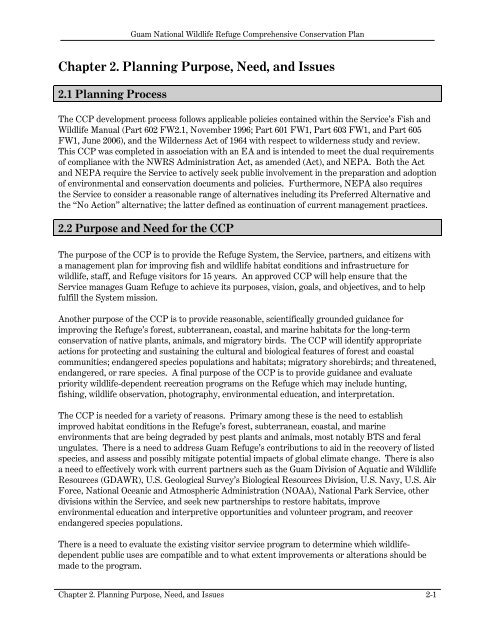Guam National Wildlife Refuge Comprehensive Conservation Plan
Guam National Wildlife Refuge Comprehensive Conservation Plan
Guam National Wildlife Refuge Comprehensive Conservation Plan
You also want an ePaper? Increase the reach of your titles
YUMPU automatically turns print PDFs into web optimized ePapers that Google loves.
<strong>Guam</strong> <strong>National</strong> <strong>Wildlife</strong> <strong>Refuge</strong> <strong>Comprehensive</strong> <strong>Conservation</strong> <strong>Plan</strong><br />
Chapter 2. <strong>Plan</strong>ning Purpose, Need, and Issues<br />
2.1 <strong>Plan</strong>ning Process<br />
The CCP development process follows applicable policies contained within the Service’s Fish and<br />
<strong>Wildlife</strong> Manual (Part 602 FW2.1, November 1996; Part 601 FW1, Part 603 FW1, and Part 605<br />
FW1, June 2006), and the Wilderness Act of 1964 with respect to wilderness study and review.<br />
This CCP was completed in association with an EA and is intended to meet the dual requirements<br />
of compliance with the NWRS Administration Act, as amended (Act), and NEPA. Both the Act<br />
and NEPA require the Service to actively seek public involvement in the preparation and adoption<br />
of environmental and conservation documents and policies. Furthermore, NEPA also requires<br />
the Service to consider a reasonable range of alternatives including its Preferred Alternative and<br />
the “No Action” alternative; the latter defined as continuation of current management practices.<br />
2.2 Purpose and Need for the CCP<br />
The purpose of the CCP is to provide the <strong>Refuge</strong> System, the Service, partners, and citizens with<br />
a management plan for improving fish and wildlife habitat conditions and infrastructure for<br />
wildlife, staff, and <strong>Refuge</strong> visitors for 15 years. An approved CCP will help ensure that the<br />
Service manages <strong>Guam</strong> <strong>Refuge</strong> to achieve its purposes, vision, goals, and objectives, and to help<br />
fulfill the System mission.<br />
Another purpose of the CCP is to provide reasonable, scientifically grounded guidance for<br />
improving the <strong>Refuge</strong>’s forest, subterranean, coastal, and marine habitats for the long-term<br />
conservation of native plants, animals, and migratory birds. The CCP will identify appropriate<br />
actions for protecting and sustaining the cultural and biological features of forest and coastal<br />
communities; endangered species populations and habitats; migratory shorebirds; and threatened,<br />
endangered, or rare species. A final purpose of the CCP is to provide guidance and evaluate<br />
priority wildlife-dependent recreation programs on the <strong>Refuge</strong> which may include hunting,<br />
fishing, wildlife observation, photography, environmental education, and interpretation.<br />
The CCP is needed for a variety of reasons. Primary among these is the need to establish<br />
improved habitat conditions in the <strong>Refuge</strong>’s forest, subterranean, coastal, and marine<br />
environments that are being degraded by pest plants and animals, most notably BTS and feral<br />
ungulates. There is a need to address <strong>Guam</strong> <strong>Refuge</strong>’s contributions to aid in the recovery of listed<br />
species, and assess and possibly mitigate potential impacts of global climate change.<br />
There is also<br />
a need to effectively work with current partners such as the <strong>Guam</strong> Division of Aquatic and <strong>Wildlife</strong><br />
Resources (GDAWR), U.S. Geological Survey’s Biological Resources Division, U.S. Navy, U.S. Air<br />
Force, <strong>National</strong> Oceanic and Atmospheric Administration (NOAA), <strong>National</strong> Park Service, other<br />
divisions within the Service, and seek new partnerships to restore habitats, improve<br />
environmental education and interpretive opportunities and volunteer program, and recover<br />
endangered species populations.<br />
There is a need to evaluate the existing visitor service program to determine which wildlifedependent<br />
public uses are compatible and to what extent improvements or alterations should be<br />
made to the program.<br />
Chapter 2. <strong>Plan</strong>ning Purpose, Need, and Issues 2-1

















